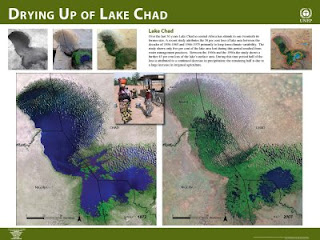-
Population-Health-Environment Video Featuring Lori Hunter Now on YouTube
›July 18, 2008 // By Sean Peoples“Population, Health, and Environment: Exploring the Connections,” an original ECSP video, offers a lively, brief, and accessible explanation of population-health-environment connections, with examples and photos from successful programs in the Philippines. Presenter Lori Hunter of the University of Colorado, Boulder, spoke at the Wilson Center earlier this year as part of ECSP’s PHE meeting series. View the video on YouTube, then rate it, comment on it, favorite it, or post a video response. -
Weekly Reading
›The authors of an article in the most recent issue of Science report that population tends to grow, not decline, around protected areas. Population growth means increased donor funding for conservation programs, they say, but high population density can negatively impact the effectiveness of such programs.
The latest volume of the journal Population and Environment, featuring contributions from former ECSP speakers Lori Hunter, Roger-Mark De Souza, and Judy Oglethorpe, examines the links between the environment and HIV/AIDS in Africa, calling for greater attention to the connections between these seemingly disparate issues.
Population growth rates and conservation are closely and inextricably linked, says a new UN Population Fund fact sheet that argues that slowing growth rates worldwide through family planning programming is a vital, and currently underfunded, component of the fight against environmental degradation.
“Countries have historically been quick to rattle their sabers over water, but they have nevertheless been content to keep them sheathed,” write ECSP Director Geoff Dabelko and ECSP Program Assistant Karin Bencala in “Water Wars: Obscuring Opportunities,” published in the Spring/Summer 2008 issue of Columbia University’s Journal of International Affairs (PDF previews), which focuses on global water issues. -
For Curitiba’s Legendary City Planners, a Rhapsody in Green
›July 2, 2008 // By Bronwen DeSena “Lessons in Governance From Urban Brazil,” a recent event co-sponsored by the Wilson Center’s Brazil Institute and Comparative Urban Studies Project, highlighted how Curitiba, the capital city of the southern state of Parana, has used urban planning to strengthen environmental security.
“Lessons in Governance From Urban Brazil,” a recent event co-sponsored by the Wilson Center’s Brazil Institute and Comparative Urban Studies Project, highlighted how Curitiba, the capital city of the southern state of Parana, has used urban planning to strengthen environmental security.
Following a rapid wave of industrialization in the 1960s, small Brazilian cities were overwhelmed by urban growth. In anticipation of growth’s negative outcomes, the city of Curitiba established the Urban Planning Institute of Curitiba (IPPUC), led by urban visionary Jamie Lerner. Concerned about degradation due to urban sprawl, Lerner created an affordable, extensive, efficient bus system—and completely altered existing road infrastructure to allow for it. Its success is unprecedented. While Curitiba has one of the highest rates of personal car ownership in Brazil, more than 70 percent of the population uses the bus to commute to work, translating into less traffic congestion and lower levels of air pollution.
Due to its flat terrain, Curitiba suffers from poor drainage and dangerous flooding. Lerner and his team established numerous urban parks to absorb floodwater and stem the damage it inflicts upon poorer city residents, who often live in more vulnerable parts of the city. Since 1965, Curitiba has broken ground on 26 separate parks.
Curitiba was also the first city in Brazil to establish mandatory recycling. Profits generated through resale of recovered material are funneled into social programs; the city often employs its homeless to help with the separation of recyclables. In one of the strongest examples of how helping people and their environment can be mutually beneficial, Curitiba encourages its favela residents to collect garbage from their neighborhoods and exchange it at designated centers for food and bus passes.
Responding to whether or not Curitiba’s plan was replicable, speaker Ivani Vassoler insisted that imitating the details of the plan was not the point—urban planners must emulate the overall approach. For determined leaders committed to what Vassoler termed a “dynamic blueprint,” the sky is the limit.
By Wilson Center Intern Bronwen DeSena.
Photo: Curitiba’s bus system, courtesy of Henri Bergius and Flickr. -
Africa Atlas’s Exquisite Images Reveal Effects of 40 Years of Environmental Degradation
›June 16, 2008 // By Daniel Gleick On June 10, at the 12th session of the African Ministerial Conference on the Environment, the UN Environment Programme (UNEP) released Africa: Atlas of Our Changing Environment, a comprehensive look at the environmental devastation being wrought in Africa. Highlighting the ecological damage caused by high population growth, climate change, and the unsustainable use of natural resources, the atlas shows before-and-after satellite images of “disappearing forests, shrinking lakes, vanishing glaciers and degraded landscapes.” The above image, courtesy of UNEP, shows how Lake Chad has shrunk to one-twentieth of its size 30 years ago.
On June 10, at the 12th session of the African Ministerial Conference on the Environment, the UN Environment Programme (UNEP) released Africa: Atlas of Our Changing Environment, a comprehensive look at the environmental devastation being wrought in Africa. Highlighting the ecological damage caused by high population growth, climate change, and the unsustainable use of natural resources, the atlas shows before-and-after satellite images of “disappearing forests, shrinking lakes, vanishing glaciers and degraded landscapes.” The above image, courtesy of UNEP, shows how Lake Chad has shrunk to one-twentieth of its size 30 years ago.
As The Independent put it: “Put it all together and you have a picture that is hard to credit, so enormous is the destruction.” Much of the impetus behind the atlas was to spur African governments to improve their environmental records.
On July 1, ECSP will host UNEP Executive Director Achim Steiner at the Washington, DC, launch of the atlas. -
Brazilian Environment Minister Marina Silva’s Resignation
› On May 13, 2008, renowned environmental defender Marina Silva, Brazil’s environment minister, resigned from her post after losing yet another political battle for control of environmental policies within the federal government. The “last straw” was President Luiz Inácio da Silva’s decision to place Minister of Strategic Affairs Roberto Mangabeira Unger, a Harvard law professor with limited experience with Amazon affairs, in charge of the highly publicized Sustainable Amazon Plan (PAS), withdrawing it from the auspices of the Ministry of Environment. Silva’s decision has had major negative repercussions and has exposed the shortcomings of Brazil’s Amazon policy.
On May 13, 2008, renowned environmental defender Marina Silva, Brazil’s environment minister, resigned from her post after losing yet another political battle for control of environmental policies within the federal government. The “last straw” was President Luiz Inácio da Silva’s decision to place Minister of Strategic Affairs Roberto Mangabeira Unger, a Harvard law professor with limited experience with Amazon affairs, in charge of the highly publicized Sustainable Amazon Plan (PAS), withdrawing it from the auspices of the Ministry of Environment. Silva’s decision has had major negative repercussions and has exposed the shortcomings of Brazil’s Amazon policy.
The daughter of poor rubber tappers who became a successful politician and a champion of the Amazon, Silva was one of the most recognized and admired members of President Lula’s government. While a member of the Revolutionary Communist Party in the 1980s, she led the Association of Rubber Tree Tappers with Chico Mendes, a pioneer of the Brazilian environmental movement who was murdered in 1988. That same year, Silva was elected to the state legislature of Acre. In 1994, she was elected to the Senate on the Worker’s Party (PT) platform, and was re-elected in 2002. During her eight years in Congress (1995-2002), Silva became a well-respected expert on sustainable development and national environmental protection issues.
Yet during her tenure as Minister of Environment, Silva lost many important battles and was rapidly becoming a merely symbolic figure. Particularly contentious was the alleged obstructionism of Brazilian Institute for Environment and Renewable Resources (IBAMA) technicians, who refused to issue environmental permits for large development projects—especially hydro-electric projects—in the Amazon region. In response, President Lula reduced Silva’s power by splitting IBAMA into two agencies and separating environmental protection from the issuance of environmental licenses. IBAMA personnel reacted with a strike.
Silva’s resignation has already had significant domestic and international ramifications. All second- and third-echelon employees in the Ministry of Environment and IBAMA resigned in solidarity with her. Jose Maria Cardoso da Silva, vice president of Conservation International-South America, called Silva’s departure a “disaster”; Anthony Hall, a development and environment specialist at the London School of Economics, noted that “her resignation will be interpreted as a weakening in the government’s concern with the environment and forest conservation.”
The day after Silva’s resignation, President Lula confirmed that she would be replaced by Carlos Minc, a well-known environmental activist and university professor who was one of the founders of Brazil’s Green Party. Minc previously served as Rio de Janeiro’s state secretary for the environment. His appointment has apparently been well-received: Agência Brasil reports that Silva is “satisfied” with her replacement.
It remains to be seen how Minc will use his new position. His love of the limelight—he follows his own dress code, which does not include a necktie, and has described himself as a “performer”—has cost him politically in his first days on his new job, as President Lula rejected public demands he made to strengthen the Ministry of Environment’s authority. Minc’s first actions as Minister of Environment suggest that he will be a vocal figure. He warned “polluters” that they should fear his ministry’s oversight. He also instigated a public fight with the governor of the state of Mato Grosso, Blairo Maggi, an influential soybean farmer, declaring—a bit sarcastically—that most of the recent increase deforestation in the Amazon has taken place in Mato Grosso. On the issue at hand, however—the issuance of environmental licenses for major development projects in the Amazon—the new minister promised to move faster and more efficiently than his predecessor.
Despite Minc’s aggressive rhetoric, questions about his effectiveness remain. They will be answered by the substance, rather than the style, of his tenure as minister. Back in the Senate, serving the remainder of her term as a representative for Acre until the end of 2010, Silva will continue to be an important voice in the ongoing debate in Brazil over how to reconcile the country’s dual objectives of promoting economic development and protecting the Amazon.
Paulo Sotero is the director of the Brazil Institute at the Woodrow Wilson International Center for Scholars. Brazil Institute Program Assistant Alan Wright contributed to this posting. -
“Development in Reverse”: ‘International Studies Quarterly’ Article Links Natural Disasters, Violence
›May 20, 2008 // By Sonia SchmanskiAlthough numerous research projects have found that environmental change can contribute to conflict “through its impact on social variables such as migration, agricultural and economic decline, and through the weakening of institutions, in particular the state,” very few analysts have systematically addressed the relationship between natural disasters and violent civil conflict, write Philip Nel and Marjolein Rightarts in “Natural Disasters and the Risk of Violent Conflict,” published in the March 2008 issue of International Studies Quarterly (subscription required). Criticizing political scientists’ tendency to diminish the importance of geography and environmental factors in assessing violence, they argue that it has become critically important to “correct this oversight.”
Recent events indicate that this attention is overdue. On May 2, Cyclone Nargis began its devastating journey through Myanmar. The latest UN estimates put the death toll at somewhere between 70,000 and 100,000. On May 12, a 7.9-magnitude earthquake struck China’s Sichuan Province (incidentally, volcanic eruptions and earthquakes top Nel and Rightarts’ list of the disasters most likely to lead to violence). Official death toll estimates currently stand at 40,000, but are likely to continue to increase. While the Chinese government has been praised both at home and abroad for the speed and scale of its response, Burma’s ruling military junta has been roundly condemned for delaying the arrival of international humanitarian assistance. It remains to be seen whether the junta’s controversial response will lead to popular rebellion among the Burmese people.
Low- and middle-income countries with high levels of inequality are most susceptible to the violence caused by natural disasters, write Nels and Rightarts. Natural disasters create openings for violent civil conflict by reducing state capacity while simultaneously increasing demands upon the state. The scramble for limited resources in the wake of a natural disaster can easily devolve into widespread violence.
“Given the dire predictions that natural disasters are set to become more frequent in the near future” due to climate change, Nel and Rightarts conclude, “conflict reduction and management strategies in the twenty-first century simply have to be more attuned to the effects of natural disasters than they have been up to now.” -
Weekly Reading
›A report commissioned by GTZ, the German government-owned technical assistance agency, examines how it can address the new challenges to development posed by climate change.
In the May/June 2008 issue of the Bulletin of the Atomic Scientists, Jürgen Scheffran provides an overview of climate-security links.
An article in Time examining population and environmental degradation highlights Robert Engelman’s new book More: Population, Nature, and What Women Want, presented recently at the Wilson Center.
Jody Williams and Wangari Maathai, who won Nobel Peace Prizes in 1997 and 2004, respectively, recently discussed climate change, environmental degradation, human security, and women’s leadership on Living on Earth. -
PODCAST – Fishing for Families: Reproductive Health and Integrated Coastal Management in the Philippines
›April 28, 2008 // By Sean PeoplesAt the Third National Population-Health-Environment (PHE) Conference in Tagaytay City, Philippines, ECSP editor Meaghan Parker spoke with Joan Castro of PATH Foundation Philippines, Inc., who manages the Integrated Population and Coastal Resource Management or IPOPCORM project. The Philippines’ rapidly rising population has overwhelmed the fisheries that have traditionally supported the country, but IPOPCORM’s innovative and integrative approach may save families along with the fish and their habitats. In the following podcast, Castro discusses how IPOPCORM’s integrated approach improves reproductive health and coastal resource management more than programs that focus exclusively on reproductive health or the environment—and at a lower total cost. A description of IPOPCORM and its results is available in “Fishing for Families,” the latest issue in our FOCUS series. For more information on population-health-environment connections, please visit our website, www.wilsoncenter.org/phe.
Showing posts from category environment.



 On June 10, at the 12th session of the
On June 10, at the 12th session of the  On May 13, 2008, renowned environmental defender
On May 13, 2008, renowned environmental defender 

